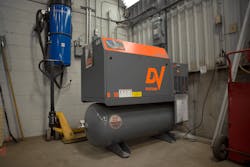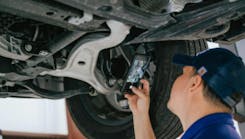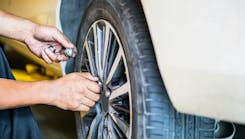Ask the Expert: What is the right air compressor for your automotive applications?
Q: What is the right air compressor for your automotive applications?
A: How do we select the appropriate type of air compressor? How do we decide between a reciprocating air compressor and rotary screw air compressor? This isn’t an exact science, and the answer isn’t black and white, but a few helpful questions will point us in the right direction:
- What do you use your compressed air for?
- How quiet do you need your air compressor?
- How energy-efficient do you want your air compressor?
Answering these questions will give us a good idea about whether a rotary screw or reciprocating air compressor is appropriate for your particular application’s needs.
Question 1: How Do You Use Your Air?
Let’s begin with our first question... What do you use your compressed air for? Or how do you use your compressed air in a typical day?
Just like compressed air tools and their activities have use-factors, the proportion of time a tool is used versus the time it isn’t, air compressors have duty-cycles, the proportion of time the air compressor can operate without the risk of overheating and sustaining excessive wear, versus the time the air compressor needs to stop and cool down, before it resumes again.
This highlight's another important point to remember: Selecting an air compressor with a duty-cycle rating appropriate for your compressed air usage is critical.
Different types of air compressors have different duty cycles. Rotary screw air compressors have a 100 percent duty-cycle and can run continuously 24/7, while pressure-lubricated heavy duty industrial piston air compressors have approximately an 80 percent maximum duty-cycle, needing to cycle off 20 percent of the time, and splash-lubricated industrial air compressors have approximately a 60 percent maximum duty-cycle, needing to cycle-off 40 percent of the time. Keep in mind these ratings refer to an eight-hour day.
Example
Auto Repair Shop
Let’s see what this means in terms of sizing and selecting an appropriate type of air compressor using the example of an auto repair shop with two bays and three technicians.
The compressed air demand is estimated to be approximately 15 SCFM. For illustrative purposes, let’s assume that 15 SCFM is the absolute maximum compressed air demand ever needed by this repair shop. It’s an unlikely circumstance in real-life, but suitable for our purposes of explanation.
We’re going to show you a simple calculation that will let you know how to size air compressors with different duty-cycles to a given compressed air demand need, in this case, 15 SCFM.
Rotary Screw Option
In terms of rotary screw air compressors, which have a 100 percent maximum duty cycle, we will divide 15 SCFM by the number 1.0, which represents a 100 percent duty cycle in decimal format. This results in 15 SCFM, meaning we need a rotary screw air compressor that can deliver at least this amount of compressed air at a maximum 100 percent duty cycle.
The Apache A5 rotary screw air compressor delivers 16 SCFM of compressed air and would meet the 15 SCFM demand while running at a 94 percent duty cycle.
Alternatively, a B5 rotary screw compressor, which delivers 18 SCFM of compressed air would meet the demand while running at an 83 percent duty cycle.
How do we know that the Apache can service the demand while running at a 94 percent duty cycle and a B5 can service this demand while running at an 83 percent duty-cycle?
Simply divide the compressed air demand of 15 SCFM by the Apache or B5’s maximum SCFM output, in this case, 16 and 18 respectively. So 15 divided by 16 equals 0.93 or 93 percent and 15 divided by 18 equals 0.83 or 83 percent.
Heavy Duty Reciprocating Option
In terms of pressure-lubricated heavy duty industrial series reciprocating air compressors with a maximum 80 percent duty cycle, we divide the 15 SCFM compressed air requirement by 0.80, which represents 80 percent in decimal form. This results in 18.75 SCFM, meaning we would need a heavy duty industrial air compressor that generates at least 18.75 SCFM.
Industrial Series Reciprocating Option
In terms of splash-lubricated industrial series reciprocating air compressors with an average maximum 60 percent duty cycle, we divide the 15 SCFM compressed air requirement by 0.60, which represents 60 percent in decimal form. This results in approximately 25 SCFM, meaning we would need a splash-lubricated industrial air compressor that generates at least 25 SCFM
Conclusion
In very general terms, if your compressed air uses are intermittent like the three bay, two technician auto repair shop example you can most likely use either a reciprocating or rotary screw air compressor, but as you can see the sizes of these air compressors will vary in terms of horsepower, depending on whether you choose a rotary screw, heavy duty industrial, or industrial line.
If your compressed air uses are primarily continuous-use, like the auto body example, a rotary screw air compressor is most likely recommended, rather than oversizing piston air compressors to meet the demand. How you answer the remaining questions will ultimately help you decide between a reciprocating or rotary screw air compressor.
Question 2 : How Quiet Do You Want It To Be?
Let’s continue on with the second question you need to ask to help determine what type of air compressor is suitable for your auto repair or auto body shop...What noise level is acceptable if noise is an issue? Do you need a relatively quiet air compressor to allow your technicians to work in peace, as well as work safely?
Let’s compare the differences between a reciprocating and rotary screw air compressor.
Rotary screw air compressors are considerably quieter.
Rotary screw air compressor technology compresses air without any mechanical contact between the rotors in the airend, causing it to be considerably quieter, with less wear.
To give you an understanding of these relative noise levels, a normal conversation at three feet registers at 70 dBa. You can stand by a rotary screw air compressor and easily have a normal conversation with someone.
Also, from a safety perspective, prolonged exposure to excessive noise levels impacts a worker’s physical health and mental well-being.
This is why reciprocating air compressors are often segregated from the main shop floor in an enclosed room or even a separate building.
If noise is a concern, and a separate, isolated space isn’t available, or too costly to construct, a rotary screw air compressor is the most appropriate and convenient solution.
Question 3: How Clean Do You Need Your Air?
The final question to ask is how clean do you need your compressed air? For some applications, such as auto body spray painting and refinishing, there is no choice, you absolutely need clean, cool, dry compressed air. The end product is directly affected by the quality of compressed air provided and the cost of refinishing is far too high to risk being contaminated with dirt, oil or water. For this type of work you absolutely need to include good quality compressed air filters and an air dryer with your air compressor.
For other activities, such as general auto repair shop compressed air tools, you have a choice:
You can run the equipment on dirty, wet air and deal with the wear and tear of the tools and equipment, or…
You can invest in compressed air filters and an air dryer and greatly improve the performance and life of your compressed air tools and equipment.
Conclusion
So let’s review the questions that need to be asked in order to properly select an air compressor for your auto repair or auto body shop:
What do you use your compressed air for? Do you use it intermittently, continuously, or both?
How quiet do you need your air compressor?
How clean do you need your compressed air?
Remember, we have provided a very general overview of the process of how to select an air compressor. This simplified take is meant to give you an introductory understanding of the process of choosing an air compressor.
Information provided by DV Systems


